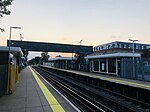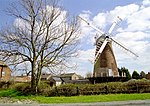Ovenden's Mill, Polegate
1817 establishments in EnglandGrade II* listed buildings in East SussexGrinding mills in the United KingdomMill museums in EnglandMuseums in East Sussex ... and 4 more
Tower mills in the United KingdomUse British English from August 2012Windmills completed in 1817Windmills in East Sussex

Ovenden's Mill or Mockett's Mill is a grade II* listed tower mill at Polegate, East Sussex, England which has been restored and is open to the public.
Excerpt from the Wikipedia article Ovenden's Mill, Polegate (License: CC BY-SA 3.0, Authors, Images).Ovenden's Mill, Polegate
Park Croft, Wealden Willingdon and Jevington
Geographical coordinates (GPS) Address Nearby Places Show on map
Geographical coordinates (GPS)
| Latitude | Longitude |
|---|---|
| N 50.815 ° | E 0.244 ° |
Address
Park Croft
Park Croft
BN26 5JT Wealden, Willingdon and Jevington
England, United Kingdom
Open on Google Maps







